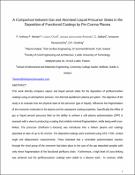Options
A comparison between gas and atomised liquid precursor states in the deposition of functional coatings by pin corona plasma
Date Issued
2011-03-22
Date Available
2014-01-24T12:01:03Z
Abstract
This work directly compares vapour and liquid aerosol states for the deposition of perfluorocarbon
coatings using an atmospheric pressure, non-thermal equilibrium plasma jet system. The objective of the
study is to evaluate how the physical state of the precursor (gas or liquid), influences the fragmentation
of the monomer molecules in the plasma and the subsequent coating properties. Specifically the effect of
gas or liquid aerosol precursor feed on the ability to achieve a soft plasma polymerisation (SPP) is
assessed with a view to producing a coating that exhibits minimal fragmentation, while being well crosslinked.
The precursor (Perfluoro–1–Decene) was introduced into a helium plasma and coatings
deposited at rates of up to 50 nm/min. The deposited coatings were examined using XPS, FTIR, contact
angle and ellipsometric measurements. These indicated that a controlled polymerization reaction
through the vinyl group of the monomer had taken place in the case of the gas deposited samples with
only minor fragmentation of the functional perfluoro chain. Furthermore, a high level of cross-linking
was achieved and the perfluorocarbon coatings were stable to a toluene wash. In contrast, while
2
coatings deposited using the liquid deposition technique showed good retention of monomer molecular
structure, they exhibited poor stability when immersed in toluene. This is attributed to lower levels of
cross-linking of the liquid precursor in the plasma, compared with coatings deposited using the gaseous
precursor technique.
coatings using an atmospheric pressure, non-thermal equilibrium plasma jet system. The objective of the
study is to evaluate how the physical state of the precursor (gas or liquid), influences the fragmentation
of the monomer molecules in the plasma and the subsequent coating properties. Specifically the effect of
gas or liquid aerosol precursor feed on the ability to achieve a soft plasma polymerisation (SPP) is
assessed with a view to producing a coating that exhibits minimal fragmentation, while being well crosslinked.
The precursor (Perfluoro–1–Decene) was introduced into a helium plasma and coatings
deposited at rates of up to 50 nm/min. The deposited coatings were examined using XPS, FTIR, contact
angle and ellipsometric measurements. These indicated that a controlled polymerization reaction
through the vinyl group of the monomer had taken place in the case of the gas deposited samples with
only minor fragmentation of the functional perfluoro chain. Furthermore, a high level of cross-linking
was achieved and the perfluorocarbon coatings were stable to a toluene wash. In contrast, while
2
coatings deposited using the liquid deposition technique showed good retention of monomer molecular
structure, they exhibited poor stability when immersed in toluene. This is attributed to lower levels of
cross-linking of the liquid precursor in the plasma, compared with coatings deposited using the gaseous
precursor technique.
Type of Material
Journal Article
Publisher
Wiley
Journal
Plasma Process and Polymers
Volume
8
Issue
3
Start Page
230
End Page
238
Copyright (Published Version)
2011 WILEY-VCH Verlag GmbH & Co. KGaA, Weinheim
Language
English
Status of Item
Peer reviewed
This item is made available under a Creative Commons License
File(s)
Loading...
Name
A_Comparison_between_Gas_and_Atomised_Liquid_Precursor_States_in_the_Deposition_of_Functional_Coatings_by_Pin_Corona_Plasma.pdf
Size
650.61 KB
Format
Adobe PDF
Checksum (MD5)
0adfea9310234209df2b010568f5f4b5
Owning collection